Laura Perry's Blog, page 25
June 18, 2014
Book Review: Divorcing a Real Witch
I’ve just read an unusual book, but it’s one we need. Divorcing a Real Witch by Diana Rajchel addresses a real need not just in the Pagan community but in the world at large. As progressive and modern as we think we are, many people still find divorce to be an awkward, uncomfortable subject, whether they’re the ones experiencing it themselves or whether they’re trying to deal with the event in a friend or family member. This book helps the reader work their way through the issues divorce brings up, both practical and spiritual.
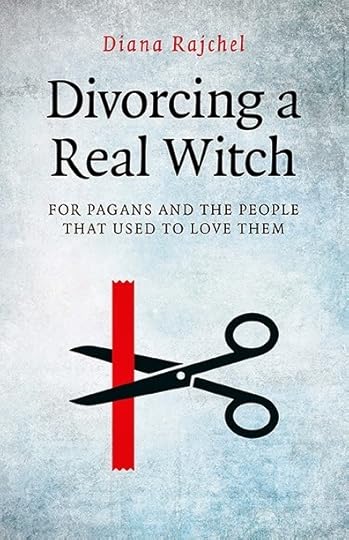
Nowhere does Ms. Rajchel condescend or preach. This is a book about making it through a difficult time and healing from it. She is very right to point out that people, especially women, feel a great deal of pressure to get married and provide their parents with grandchildren, among other requirements. To this end, many people view divorce as a failure. It is not. It is often the best solution to a bad situation.
Ms. Rajchel walks the reader through several different approaches to dealing with divorce, from handling the inevitable feelings of shame and failure, to finding a life for yourself outside a relationship. I am especially impressed by her handparting ritual. I included such a ritual in my recent book Ariadne’s Thread and I honestly felt a little awkward doing so. We are so well trained to believe that the breakup of a marriage is a failure that acknowledging it with a ritual seems almost inappropriate. Well, it’s not. We need to recognize the changes in our lives, the shifts from one stage of existence to another. We also need to admit that no one is perfect and that people change over time, two facts that often lead to the end of a relationship.
I wish I had read this book twenty years ago, when I went through a divorce. It probably wouldn’t have lessened my pain, but it would have given me the tools to deal with it and move forward in my life more easily. If you or someone you know is dealing with the collapse of a marriage, this book is definitely worth your time.

Nowhere does Ms. Rajchel condescend or preach. This is a book about making it through a difficult time and healing from it. She is very right to point out that people, especially women, feel a great deal of pressure to get married and provide their parents with grandchildren, among other requirements. To this end, many people view divorce as a failure. It is not. It is often the best solution to a bad situation.
Ms. Rajchel walks the reader through several different approaches to dealing with divorce, from handling the inevitable feelings of shame and failure, to finding a life for yourself outside a relationship. I am especially impressed by her handparting ritual. I included such a ritual in my recent book Ariadne’s Thread and I honestly felt a little awkward doing so. We are so well trained to believe that the breakup of a marriage is a failure that acknowledging it with a ritual seems almost inappropriate. Well, it’s not. We need to recognize the changes in our lives, the shifts from one stage of existence to another. We also need to admit that no one is perfect and that people change over time, two facts that often lead to the end of a relationship.
I wish I had read this book twenty years ago, when I went through a divorce. It probably wouldn’t have lessened my pain, but it would have given me the tools to deal with it and move forward in my life more easily. If you or someone you know is dealing with the collapse of a marriage, this book is definitely worth your time.
Published on June 18, 2014 05:15
June 5, 2014
A Witch's Brew or Two
In addition to brewing mead and wine, a couple times a year I mix up some cordials and liqueurs, just because I can. I invite you to try these recipes as well - they're easy and delicious, and way cheaper than the store-bought versions.
In the past I’ve made Balm Water, Parfait d’Amour, coconut liqueur and kümmel. Given that the elder bushes are blooming right now and I need to use up the rest of last year’s blackberries from the freezer, this time I’m brewing up some Blackberry Liqueur and a lovely Elderflower Cordial.
Even if you’ve never concocted a steeped or brewed beverage before, these are easy to make. There’s no long-term, large-scale brewing like with wine or beer. Just mix these up and they do their thing with little to no help. They don’t require any special equipment or hard-to-find ingredients.
First, the cordial. I picked the elderflowers (traditionally termed ‘elder blow’) late in the morning, after the dew had dried but before the sun had shone on them long enough to evaporate too much of their scent.
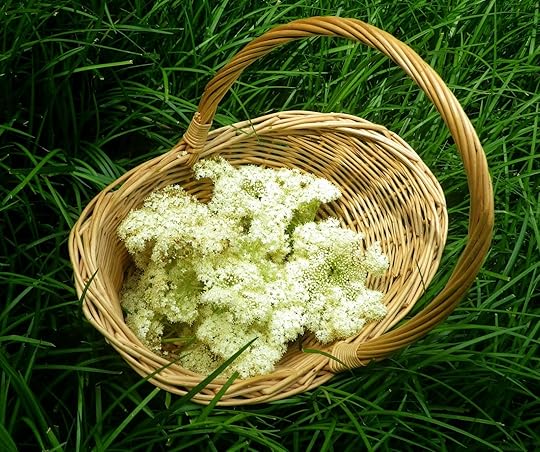
My cat even stopped to have a sniff – it’s a lovely, if unusual, fragrance.
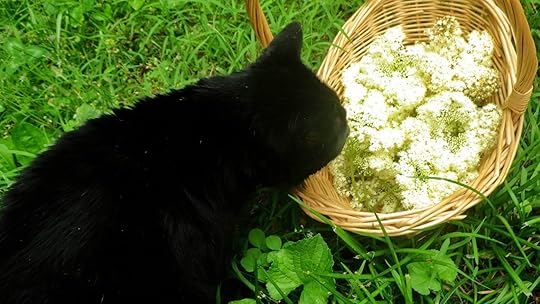
I gather my elderflowers from the bush at the edge of my garden (OK, it’s tall enough to be a tree, but it’s still technically a shrub). If you’re wildcrafting, be very careful. Pick blossoms only after you, or someone with the appropriate knowledge, has firmly identified the plant. The blossoms of the very poisonous water hemlock plant look an awful lot like elderflowers (though the actual plants don’t look terribly similar).
I adapted my recipe for Elderflower Cordial from two similar-but-not-same recipes in The Country Store by Stephanie Donaldson and Country Ways and Wisdom by Rosamond Richardson. It makes close to a gallon of finished cordial. And I apologize to my non-U.S. readers; my measurements are all in cups, which I realize is positively primitive compared to the rest of the world! On to the recipe…
HOMEMADE ELDERFLOWER CORDIAL
7 cups granulated (caster) sugar
6 cups water
¼ cup citric acid powder **
25 fresh elderflower heads
1 lemon, thinly sliced (if waxed, scrub it well first)
** Citric acid can be found in the canning section of large supermarkets; it’s often labeled ‘fruit fresh’ or something similar. I buy it at the Indian market, where it’s really cheap and comes in large packets.
In a large pot, heat the sugar and water together, stirring occasionally, until the sugar dissolves completely and the mixture is clear. Set aside to cool to room temperature. Pour the sugar-water mixture into a clean container (I use the ceramic insert from my slow cooker) and stir in the citric acid until it dissolves. Snip the flowers from the bloom heads and discard as much of the stem as you reasonably can – removing the stem gives the cordial a more delicate flavor. Stir the blooms and the lemon slices into the liquid until the flowers are well saturated. It will look like this:
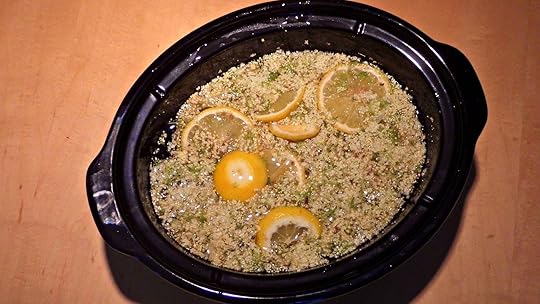
Cover the container loosely (I use the lid that goes with the slow cooker insert and tilt it slightly) and let sit for two to three days, away from heat and light. I like to give the mixture a gentle stir once a day. The longer you leave it to sit, the stronger the elderflower flavor will be, but don’t go longer than three days or the cordial will start to get bitter.
When it has sat long enough for your taste, strain the mixture into clean bottles or jars. Now you have two choices:
1. Cover the tops of the bottles or jars with cheesecloth and let them stand at warmish room temperature for up to a week so a little natural fermentation can take place.
Or
2. Seal the bottles with lids or corks and store in the refrigerator to prevent fermentation.
Your choice. Even with the fermentation, it’s not going to be a very strong drink, just a teeny bit fizzy. I like to store it in the fridge and mix with sparkling water (or champagne!) for a delightful summer refresher.
Now on to the berry brew…
BLACKBERRY LIQUEUR
2 cups water
1 cup granulated (caster) sugar
1 pound blackberries (if frozen, thaw them first)
2 cups good quality vodka (if your vodka isn’t drinkable, the liqueur won’t be, either)
In a saucepan, heat the water and sugar together, stirring occasionally, until the sugar dissolves and the mixture is clear. Set aside to cool to room temperature. Crush the berries with a potato masher or give them a quick spin in the food processor (you want to chop them up, not puree them) and pour them into your brewing container. I like to use a gallon glass jug that apple cider came in, but any large jar or crock will work. Add the vodka and sugar-water mixture and stir well to combine. It will look like this:
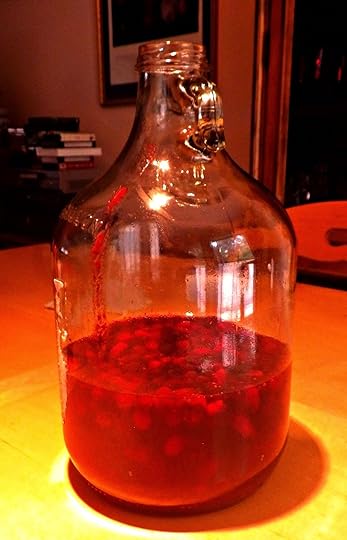
Cover the container in a way that lets air in and out but keeps out bugs, dust and so on. A thin piece of cloth secured over the top with string or rubber bands is sufficient. In addition to just steeping so the flavors mix, the concoction is liable to actually ferment a little, so you don’t want to seal it tightly.
Put it somewhere away from heat and light and let it stand for about six weeks. I like to give it a good stir/shake at least once a week to make sure the flavors are blending well.
At the end of the six weeks, strain the mixture into bottles or jars and seal. This one stores at room temperature nicely and, due to the alcohol content, will keep for ages (though it’s not likely to last that long at my house). If you like Chambord, you’ll like this stuff and can substitute it in drinks and recipes.
Enjoy!
In the past I’ve made Balm Water, Parfait d’Amour, coconut liqueur and kümmel. Given that the elder bushes are blooming right now and I need to use up the rest of last year’s blackberries from the freezer, this time I’m brewing up some Blackberry Liqueur and a lovely Elderflower Cordial.
Even if you’ve never concocted a steeped or brewed beverage before, these are easy to make. There’s no long-term, large-scale brewing like with wine or beer. Just mix these up and they do their thing with little to no help. They don’t require any special equipment or hard-to-find ingredients.
First, the cordial. I picked the elderflowers (traditionally termed ‘elder blow’) late in the morning, after the dew had dried but before the sun had shone on them long enough to evaporate too much of their scent.

My cat even stopped to have a sniff – it’s a lovely, if unusual, fragrance.

I gather my elderflowers from the bush at the edge of my garden (OK, it’s tall enough to be a tree, but it’s still technically a shrub). If you’re wildcrafting, be very careful. Pick blossoms only after you, or someone with the appropriate knowledge, has firmly identified the plant. The blossoms of the very poisonous water hemlock plant look an awful lot like elderflowers (though the actual plants don’t look terribly similar).
I adapted my recipe for Elderflower Cordial from two similar-but-not-same recipes in The Country Store by Stephanie Donaldson and Country Ways and Wisdom by Rosamond Richardson. It makes close to a gallon of finished cordial. And I apologize to my non-U.S. readers; my measurements are all in cups, which I realize is positively primitive compared to the rest of the world! On to the recipe…
HOMEMADE ELDERFLOWER CORDIAL
7 cups granulated (caster) sugar
6 cups water
¼ cup citric acid powder **
25 fresh elderflower heads
1 lemon, thinly sliced (if waxed, scrub it well first)
** Citric acid can be found in the canning section of large supermarkets; it’s often labeled ‘fruit fresh’ or something similar. I buy it at the Indian market, where it’s really cheap and comes in large packets.
In a large pot, heat the sugar and water together, stirring occasionally, until the sugar dissolves completely and the mixture is clear. Set aside to cool to room temperature. Pour the sugar-water mixture into a clean container (I use the ceramic insert from my slow cooker) and stir in the citric acid until it dissolves. Snip the flowers from the bloom heads and discard as much of the stem as you reasonably can – removing the stem gives the cordial a more delicate flavor. Stir the blooms and the lemon slices into the liquid until the flowers are well saturated. It will look like this:

Cover the container loosely (I use the lid that goes with the slow cooker insert and tilt it slightly) and let sit for two to three days, away from heat and light. I like to give the mixture a gentle stir once a day. The longer you leave it to sit, the stronger the elderflower flavor will be, but don’t go longer than three days or the cordial will start to get bitter.
When it has sat long enough for your taste, strain the mixture into clean bottles or jars. Now you have two choices:
1. Cover the tops of the bottles or jars with cheesecloth and let them stand at warmish room temperature for up to a week so a little natural fermentation can take place.
Or
2. Seal the bottles with lids or corks and store in the refrigerator to prevent fermentation.
Your choice. Even with the fermentation, it’s not going to be a very strong drink, just a teeny bit fizzy. I like to store it in the fridge and mix with sparkling water (or champagne!) for a delightful summer refresher.
Now on to the berry brew…
BLACKBERRY LIQUEUR
2 cups water
1 cup granulated (caster) sugar
1 pound blackberries (if frozen, thaw them first)
2 cups good quality vodka (if your vodka isn’t drinkable, the liqueur won’t be, either)
In a saucepan, heat the water and sugar together, stirring occasionally, until the sugar dissolves and the mixture is clear. Set aside to cool to room temperature. Crush the berries with a potato masher or give them a quick spin in the food processor (you want to chop them up, not puree them) and pour them into your brewing container. I like to use a gallon glass jug that apple cider came in, but any large jar or crock will work. Add the vodka and sugar-water mixture and stir well to combine. It will look like this:

Cover the container in a way that lets air in and out but keeps out bugs, dust and so on. A thin piece of cloth secured over the top with string or rubber bands is sufficient. In addition to just steeping so the flavors mix, the concoction is liable to actually ferment a little, so you don’t want to seal it tightly.
Put it somewhere away from heat and light and let it stand for about six weeks. I like to give it a good stir/shake at least once a week to make sure the flavors are blending well.
At the end of the six weeks, strain the mixture into bottles or jars and seal. This one stores at room temperature nicely and, due to the alcohol content, will keep for ages (though it’s not likely to last that long at my house). If you like Chambord, you’ll like this stuff and can substitute it in drinks and recipes.
Enjoy!
Published on June 05, 2014 04:35
May 14, 2014
Wedge a Bit of Poetry in There
I've written a lot of rituals over the years, by myself or collaborating with one or more other Pagan clergy. Sometimes I end up writing original verse and chants for the 'high points' of the ceremony, but often I find someone else has already come up with words that are better than anything I can muster. I don't mean invocations and other bits from contemporary Pagan books, though I certainly enjoy those. I mean poetry - the stuff my high school English teacher forced me to slog through, a fact for which I am now (belatedly) grateful.
I thought I would share a few of my favorite poetic bits with you today, words that have inspired me and let me wrap a ritual around them, at the turning of the moon tides or the turning of the seasons. Sometimes it's enough just to read the poem, out loud or silently, and let it seep in as you meditate. And sometimes these poems beg to be shared with a wider audience, their sentiments brought alive by the vibration of voices around a circle. Perhaps they will inspire you as well. Here we go:

First, an excerpt from the poem Hertha by Algernon Charles Swinburne:
I am that which began;
Out of me the years roll;
Out of me God and man;
I am equal and whole;
God changes, and man, and the form of them bodily; I am the soul.
Before ever land was,
Before ever the sea,
Or soft hair of the grass,
Or fair limbs of the tree,
Or the fresh-coloured fruit of my branches, I was, and thy soul was in me.
First life on my sources
First drifted and swam;
Out of me are the forces
That save it or damn;
Out of me man and woman, and wild-beast and bird; before God was, I am.
Beside or above me
Nought is there to go;
Love or unlove me,
Unknow me or know,
I am that which unloves me and loves; I am stricken, and I am the blow.
I the mark that is missed
And the arrows that miss,
I the mouth that is kissed
And the breath in the kiss,
The search, and the sought, and the seeker, the soul and the body that is.
I am that thing which blesses
My spirit elate;
That which caresses
With hands uncreate
My limbs unbegotten that measure the length of the measure of fate.
But what thing dost thou now,
Looking Godward, to cry
"I am I, thou art thou,
I am low, thou art high"?
I am thou, whom thou seekest to find him; find thou but thyself, thou art I.

A short bit from the 20th century black American poet, novelist and playwright Langston Hughes. I'm sure he would find it ironic that I, a polytheistic Pagan, use the words that he, a non-theistic humanist, wrote:
Oh, God of Dust and Rainbows,
Help us to see
That without the dust the rainbow
Would not be.

Profound words of transformation from the 13th-century Persian poet Jalal ad-Din Rumi:
Every midwife knows
that not until a mother’s womb
softens from the pain of labour
will a way unfold
and the infant find that opening to be born.
Oh friend!
There is treasure in your heart,
it is heavy with child.
Listen.
All the awakened ones,
like trusted midwives are saying,
'welcome this pain.'
It opens the dark passage of Grace.

How about a bit of seasonal verse from Edward Dowden, titled In September:
Spring scarce had greener fields to show than these
Of mid September; through the still warm noon
The rivulets ripple forth a gladder tune
Than ever in the summer; from the trees
Dusk-green, and murmuring inward melodies,
No leaf drops yet; only our evenings swoon
In pallid skies more suddenly, and the moon
Finds motionless white mists out on the leas.

Another one from Swinburne; this time, the whole poem. This one is titled The Garden of Proserpine:
Here, where the world is quiet;
Here, where all trouble seems
Dead winds' and spent waves' riot
In doubtful dreams of dreams;
I watch the green field growing
For reaping folk and sowing,
For harvest-time and mowing,
A sleepy world of streams.
I am tired of tears and laughter,
And men that laugh and weep;
Of what may come hereafter
For men that sow to reap:
I am weary of days and hours,
Blown buds of barren flowers,
Desires and dreams and powers
And everything but sleep.
Here life has death for neighbour,
And far from eye or ear
Wan waves and wet winds labour,
Weak ships and spirits steer;
They drive adrift, and whither
They wot not who make thither;
But no such winds blow hither,
And no such things grow here.
No growth of moor or coppice,
No heather-flower or vine,
But bloomless buds of poppies,
Green grapes of Proserpine,
Pale beds of blowing rushes
Where no leaf blooms or blushes
Save this whereout she crushes
For dead men deadly wine.
Pale, without name or number,
In fruitless fields of corn,
They bow themselves and slumber
All night till light is born;
And like a soul belated,
In hell and heaven unmated,
By cloud and mist abated
Comes out of darkness morn.
Though one were strong as seven,
He too with death shall dwell,
Nor wake with wings in heaven,
Nor weep for pains in hell;
Though one were fair as roses,
His beauty clouds and closes;
And well though love reposes,
In the end it is not well.
Pale, beyond porch and portal,
Crowned with calm leaves, she stands
Who gathers all things mortal
With cold immortal hands;
Her languid lips are sweeter
Than love's who fears to greet her
To men that mix and meet her
From many times and lands.
She waits for each and other,
She waits for all men born;
Forgets the earth her mother,
The life of fruits and corn;
And spring and seed and swallow
Take wing for her and follow
Where summer song rings hollow
And flowers are put to scorn.
There go the loves that wither,
The old loves with wearier wings;
And all dead years draw thither,
And all disastrous things;
Dead dreams of days forsaken,
Blind buds that snows have shaken,
Wild leaves that winds have taken,
Red strays of ruined springs.
We are not sure of sorrow,
And joy was never sure;
To-day will die to-morrow;
Time stoops to no man's lure;
And love, grown faint and fretful,
With lips but half regretful
Sighs, and with eyes forgetful
Weeps that no loves endure.
From too much love of living,
From hope and fear set free,
We thank with brief thanksgiving
Whatever gods may be
That no life lives for ever;
That dead men rise up never;
That even the weariest river
Winds somewhere safe to sea.
Then star nor sun shall waken,
Nor any change of light:
Nor sound of waters shaken,
Nor any sound or sight:
Nor wintry leaves nor vernal,
Nor days nor things diurnal;
Only the sleep eternal
In an eternal night.

And finally, I leave you with the wise words of Native American writer Linda K. Hogan:
Walking, I am listening to a deeper way. Suddenly all my ancestors are behind me. Be still, they say. Watch and listen. You are the result of the love of thousands.
I thought I would share a few of my favorite poetic bits with you today, words that have inspired me and let me wrap a ritual around them, at the turning of the moon tides or the turning of the seasons. Sometimes it's enough just to read the poem, out loud or silently, and let it seep in as you meditate. And sometimes these poems beg to be shared with a wider audience, their sentiments brought alive by the vibration of voices around a circle. Perhaps they will inspire you as well. Here we go:

First, an excerpt from the poem Hertha by Algernon Charles Swinburne:
I am that which began;
Out of me the years roll;
Out of me God and man;
I am equal and whole;
God changes, and man, and the form of them bodily; I am the soul.
Before ever land was,
Before ever the sea,
Or soft hair of the grass,
Or fair limbs of the tree,
Or the fresh-coloured fruit of my branches, I was, and thy soul was in me.
First life on my sources
First drifted and swam;
Out of me are the forces
That save it or damn;
Out of me man and woman, and wild-beast and bird; before God was, I am.
Beside or above me
Nought is there to go;
Love or unlove me,
Unknow me or know,
I am that which unloves me and loves; I am stricken, and I am the blow.
I the mark that is missed
And the arrows that miss,
I the mouth that is kissed
And the breath in the kiss,
The search, and the sought, and the seeker, the soul and the body that is.
I am that thing which blesses
My spirit elate;
That which caresses
With hands uncreate
My limbs unbegotten that measure the length of the measure of fate.
But what thing dost thou now,
Looking Godward, to cry
"I am I, thou art thou,
I am low, thou art high"?
I am thou, whom thou seekest to find him; find thou but thyself, thou art I.

A short bit from the 20th century black American poet, novelist and playwright Langston Hughes. I'm sure he would find it ironic that I, a polytheistic Pagan, use the words that he, a non-theistic humanist, wrote:
Oh, God of Dust and Rainbows,
Help us to see
That without the dust the rainbow
Would not be.

Profound words of transformation from the 13th-century Persian poet Jalal ad-Din Rumi:
Every midwife knows
that not until a mother’s womb
softens from the pain of labour
will a way unfold
and the infant find that opening to be born.
Oh friend!
There is treasure in your heart,
it is heavy with child.
Listen.
All the awakened ones,
like trusted midwives are saying,
'welcome this pain.'
It opens the dark passage of Grace.

How about a bit of seasonal verse from Edward Dowden, titled In September:
Spring scarce had greener fields to show than these
Of mid September; through the still warm noon
The rivulets ripple forth a gladder tune
Than ever in the summer; from the trees
Dusk-green, and murmuring inward melodies,
No leaf drops yet; only our evenings swoon
In pallid skies more suddenly, and the moon
Finds motionless white mists out on the leas.

Another one from Swinburne; this time, the whole poem. This one is titled The Garden of Proserpine:
Here, where the world is quiet;
Here, where all trouble seems
Dead winds' and spent waves' riot
In doubtful dreams of dreams;
I watch the green field growing
For reaping folk and sowing,
For harvest-time and mowing,
A sleepy world of streams.
I am tired of tears and laughter,
And men that laugh and weep;
Of what may come hereafter
For men that sow to reap:
I am weary of days and hours,
Blown buds of barren flowers,
Desires and dreams and powers
And everything but sleep.
Here life has death for neighbour,
And far from eye or ear
Wan waves and wet winds labour,
Weak ships and spirits steer;
They drive adrift, and whither
They wot not who make thither;
But no such winds blow hither,
And no such things grow here.
No growth of moor or coppice,
No heather-flower or vine,
But bloomless buds of poppies,
Green grapes of Proserpine,
Pale beds of blowing rushes
Where no leaf blooms or blushes
Save this whereout she crushes
For dead men deadly wine.
Pale, without name or number,
In fruitless fields of corn,
They bow themselves and slumber
All night till light is born;
And like a soul belated,
In hell and heaven unmated,
By cloud and mist abated
Comes out of darkness morn.
Though one were strong as seven,
He too with death shall dwell,
Nor wake with wings in heaven,
Nor weep for pains in hell;
Though one were fair as roses,
His beauty clouds and closes;
And well though love reposes,
In the end it is not well.
Pale, beyond porch and portal,
Crowned with calm leaves, she stands
Who gathers all things mortal
With cold immortal hands;
Her languid lips are sweeter
Than love's who fears to greet her
To men that mix and meet her
From many times and lands.
She waits for each and other,
She waits for all men born;
Forgets the earth her mother,
The life of fruits and corn;
And spring and seed and swallow
Take wing for her and follow
Where summer song rings hollow
And flowers are put to scorn.
There go the loves that wither,
The old loves with wearier wings;
And all dead years draw thither,
And all disastrous things;
Dead dreams of days forsaken,
Blind buds that snows have shaken,
Wild leaves that winds have taken,
Red strays of ruined springs.
We are not sure of sorrow,
And joy was never sure;
To-day will die to-morrow;
Time stoops to no man's lure;
And love, grown faint and fretful,
With lips but half regretful
Sighs, and with eyes forgetful
Weeps that no loves endure.
From too much love of living,
From hope and fear set free,
We thank with brief thanksgiving
Whatever gods may be
That no life lives for ever;
That dead men rise up never;
That even the weariest river
Winds somewhere safe to sea.
Then star nor sun shall waken,
Nor any change of light:
Nor sound of waters shaken,
Nor any sound or sight:
Nor wintry leaves nor vernal,
Nor days nor things diurnal;
Only the sleep eternal
In an eternal night.

And finally, I leave you with the wise words of Native American writer Linda K. Hogan:
Walking, I am listening to a deeper way. Suddenly all my ancestors are behind me. Be still, they say. Watch and listen. You are the result of the love of thousands.
Published on May 14, 2014 04:49
May 7, 2014
Would You Like Values with That?
Have you noticed that our society urges us to choose our friends and romantic partners based on physical attributes, religious tradition or favorite activities? A friend once complained to me that he liked brunettes, and there were plenty of them out there, but he just couldn’t manage to find the right one for a relationship that would last. I’ve had other friends grumble that they can’t find a romantic partner or good, close friends within their religion but they’re unwilling to look outside that tradition. Despite cultural pressure to pick and choose based on particular characteristics, how about deciding who we spend our time with based on how compatible their values are with ours? That leads to a deeper problem: How do you figure out what your values are?
Just being a part of a religious tradition doesn’t necessarily dictate your values. They’re not automatically the same as spiritual beliefs. They’re more like ideals or life principles – the concepts you base all your judgments on. And I've seen quite a wide variety within both the Pagan community and among the Christians I know. Your values may align to a certain extent with your political preferences and to a certain extent with your spiritual tradition. One helpful bit of information to keep in mind is this: Someone, somewhere has probably already hammered out a set of principles that are pretty close to yours. You don’t have to start from scratch.
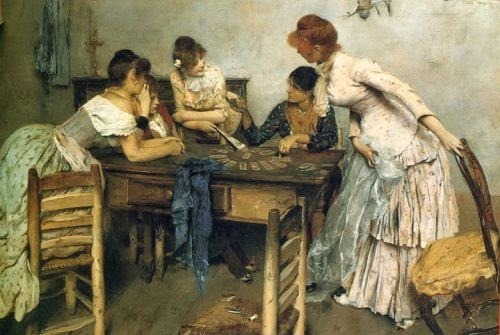
I was first introduced to the concept of life values when I briefly attended a Unitarian Universalist church when I was a teenager. That was a radical act for small-town Florida, let me tell you. Some people thought UUs were practically hippies - oh, the horror! Rather than a required dogma of beliefs, the UUs have a set of principles they support. At the time I was still struggling with my own spiritual identity so I didn’t pay a whole lot of attention to that information. But many years later, as I was working to put my worldview into words, I rediscovered the principles when I began occasionally attending two local UU churches in addition to my Pagan activities.
The seven Unitarian Universalist principles are:
The inherent worth and dignity of every person;Justice, equity and compassion in human relations;Acceptance of one another and encouragement to spiritual growth in our congregations;A free and responsible search for truth and meaning;The right of conscience and the use of the democratic process within our congregations and in society at large;The goal of world community with peace, liberty, and justice for all;Respect for the interdependent web of all existence of which we are a part.
I don’t identify as a UU even though I occasionally attend a UU church. I’m Pagan. But I do identify, very strongly, with these principles. I have tweaked them a bit for my own use (I drop the ‘in our congregations’ part from the third principle and the ‘within our congregations’ from the fifth, for example) but overall, these are the values I live by. They inform my decisions about who I vote for, how I support human rights and civil rights issues, and how I choose my friends.

The people I spend time with share my values. They may be Democrats, Libertarians, Greens, Populists, Independents, or something else entirely. They may be Pagan, Christian, Jewish, Muslim, atheist, or some other tradition (or lack thereof). Their skin, hair and eyes may be of any color and their ancestors may be from any region of the globe. They may identify anywhere along the gender and sexuality spectrum. But they share the most important trait of all: a set of life values that mesh with mine.
Do these principles resonate with you? Do you disagree with them? Would you change any of them? Answering these questions puts you on the path to defining your own life values. Once you’ve done that, you can begin to spend time with people whose deepest principles beat in time with yours. And that makes for truly lasting relationships of all kinds.
Just being a part of a religious tradition doesn’t necessarily dictate your values. They’re not automatically the same as spiritual beliefs. They’re more like ideals or life principles – the concepts you base all your judgments on. And I've seen quite a wide variety within both the Pagan community and among the Christians I know. Your values may align to a certain extent with your political preferences and to a certain extent with your spiritual tradition. One helpful bit of information to keep in mind is this: Someone, somewhere has probably already hammered out a set of principles that are pretty close to yours. You don’t have to start from scratch.

I was first introduced to the concept of life values when I briefly attended a Unitarian Universalist church when I was a teenager. That was a radical act for small-town Florida, let me tell you. Some people thought UUs were practically hippies - oh, the horror! Rather than a required dogma of beliefs, the UUs have a set of principles they support. At the time I was still struggling with my own spiritual identity so I didn’t pay a whole lot of attention to that information. But many years later, as I was working to put my worldview into words, I rediscovered the principles when I began occasionally attending two local UU churches in addition to my Pagan activities.
The seven Unitarian Universalist principles are:
The inherent worth and dignity of every person;Justice, equity and compassion in human relations;Acceptance of one another and encouragement to spiritual growth in our congregations;A free and responsible search for truth and meaning;The right of conscience and the use of the democratic process within our congregations and in society at large;The goal of world community with peace, liberty, and justice for all;Respect for the interdependent web of all existence of which we are a part.
I don’t identify as a UU even though I occasionally attend a UU church. I’m Pagan. But I do identify, very strongly, with these principles. I have tweaked them a bit for my own use (I drop the ‘in our congregations’ part from the third principle and the ‘within our congregations’ from the fifth, for example) but overall, these are the values I live by. They inform my decisions about who I vote for, how I support human rights and civil rights issues, and how I choose my friends.

The people I spend time with share my values. They may be Democrats, Libertarians, Greens, Populists, Independents, or something else entirely. They may be Pagan, Christian, Jewish, Muslim, atheist, or some other tradition (or lack thereof). Their skin, hair and eyes may be of any color and their ancestors may be from any region of the globe. They may identify anywhere along the gender and sexuality spectrum. But they share the most important trait of all: a set of life values that mesh with mine.
Do these principles resonate with you? Do you disagree with them? Would you change any of them? Answering these questions puts you on the path to defining your own life values. Once you’ve done that, you can begin to spend time with people whose deepest principles beat in time with yours. And that makes for truly lasting relationships of all kinds.
Published on May 07, 2014 04:21
April 30, 2014
Focusing on Sacred Space
How do you mark the sacred space when you're about to enter into meditation, perform a spell or enact a ritual? Yes, all space is sacred, but I've never known anyone who can focus on all of (possibly infinite) space at once. We need to narrow it down to the particular area we're in at the time in order to have a finite, defined chunk of All-That-Is to focus on.
Many ancient spiritual traditions involved permanent sacred locations: temples, groves, stone circles and the like. In these cases, the setting defines the sacred space. Sure, you can purify it and bless it and all that, but it's already there, already marked and waiting for you.
 Castlerigg Stone Circle
Castlerigg Stone Circle
What if you don't have a permanent building or space? Maybe you're going to have a ritual in a public park, or do a meditation in your back yard, or cast a spell in your living room. You need to mark out - physically or in your mind - the limits of the space in which you'll be 'doing your thing.'
You might walk around the perimeter of the area, or carry a broom and sweep around it, or use a ritual blade to mark a circle in the air or on the ground. You could sprinkle salt or some other substance (I use flour or white sand outdoors since salt will damage plants) to mark the edge of your sacred space. You could carry incense around the edge of the area to simultaneously define and purify/bless it. Or you could simply sit still and visualize a circle/sphere or other shape building around you in the ether.

In addition to the physical marking of the sacred space, I like to use a bit of poetry or chant to help me focus on the act, especially when I'm doing ritual with a number of people. Over the years I've used a wide variety of verses in the public rituals I've performed. Here's a bit of rhyme I used with a small group that I ran for a while, when we held rituals at the full moon:
You could substitute other Powers and energies for the dragons and trees, depending on the purpose of your ritual. I've called on the Land Wights, the Fae and the Ancestors at various times when that was appropriate to the event. When I run rituals that focus on guided visualizations or shamanic journeying, I often say these words as I'm marking out the working space:
Over the years I've done a lot of work with goddesses from different pantheons. When a female deity is involved in the working, I like to use a circle-casting verse I wrote that invokes Her energy and protection:

Here's a poetic choice for goddess-centered ceremonies; I wrote this one for the New Moon Ritual included in Ariadne's Thread:
One of my favorite ways of marking sacred space involves all the participants working together. This is especially suitable for events involving children. Everyone stands in a circle, fairly close together. The first person reaches their left hand out and takes hold of the right hand of the person next to them (the second person). As they do so, they say, "Hand to hand the circle is cast." The second person then reaches out to hold hands with the third person, repeating the words, and so on around the circle. When all hands are linked, the leader then declares, "The circle is cast" and everyone lets go. This is an excellent way not only to generate the division between sacred and mundane space, but also to develop a sense of community and intimacy among the participants in the ritual. You would think it would be unsuitable for large groups since it would take a long time to complete, but I've seen it used effectively with up to fifty people. All the participants watch the connection form around the circle. They see it with their own eyes, and their perception of the circle growing around the group increases the intensity of the connection. It can be quite moving.
Many ancient spiritual traditions involved permanent sacred locations: temples, groves, stone circles and the like. In these cases, the setting defines the sacred space. Sure, you can purify it and bless it and all that, but it's already there, already marked and waiting for you.
 Castlerigg Stone Circle
Castlerigg Stone CircleWhat if you don't have a permanent building or space? Maybe you're going to have a ritual in a public park, or do a meditation in your back yard, or cast a spell in your living room. You need to mark out - physically or in your mind - the limits of the space in which you'll be 'doing your thing.'
You might walk around the perimeter of the area, or carry a broom and sweep around it, or use a ritual blade to mark a circle in the air or on the ground. You could sprinkle salt or some other substance (I use flour or white sand outdoors since salt will damage plants) to mark the edge of your sacred space. You could carry incense around the edge of the area to simultaneously define and purify/bless it. Or you could simply sit still and visualize a circle/sphere or other shape building around you in the ether.

In addition to the physical marking of the sacred space, I like to use a bit of poetry or chant to help me focus on the act, especially when I'm doing ritual with a number of people. Over the years I've used a wide variety of verses in the public rituals I've performed. Here's a bit of rhyme I used with a small group that I ran for a while, when we held rituals at the full moon:
Dragons and trees circle 'round
As we call the old moon down.
Brother, sister, family, friends,
A rolling hoop that never ends.
You could substitute other Powers and energies for the dragons and trees, depending on the purpose of your ritual. I've called on the Land Wights, the Fae and the Ancestors at various times when that was appropriate to the event. When I run rituals that focus on guided visualizations or shamanic journeying, I often say these words as I'm marking out the working space:
We journey tonight within and beyond. I mark the beginning of our journey. I mark the sacred circle of ritual and of life.
Over the years I've done a lot of work with goddesses from different pantheons. When a female deity is involved in the working, I like to use a circle-casting verse I wrote that invokes Her energy and protection:
Between the worlds we gather now
From time and space and mind
A journey safe in goddess’ womb
Till out we once more climb

Here's a poetic choice for goddess-centered ceremonies; I wrote this one for the New Moon Ritual included in Ariadne's Thread:
I cast about with ancient Art
The Temple of the Goddess true
Whose essence lives within my heart
Whose presence lets me start anew
One of my favorite ways of marking sacred space involves all the participants working together. This is especially suitable for events involving children. Everyone stands in a circle, fairly close together. The first person reaches their left hand out and takes hold of the right hand of the person next to them (the second person). As they do so, they say, "Hand to hand the circle is cast." The second person then reaches out to hold hands with the third person, repeating the words, and so on around the circle. When all hands are linked, the leader then declares, "The circle is cast" and everyone lets go. This is an excellent way not only to generate the division between sacred and mundane space, but also to develop a sense of community and intimacy among the participants in the ritual. You would think it would be unsuitable for large groups since it would take a long time to complete, but I've seen it used effectively with up to fifty people. All the participants watch the connection form around the circle. They see it with their own eyes, and their perception of the circle growing around the group increases the intensity of the connection. It can be quite moving.
Published on April 30, 2014 05:31
April 23, 2014
Always Check Their Baggage
Always check their baggage. No, I'm not training you to be a TSA agent. This is much more important than that.

I regularly see online memes exhorting me to get rid of the negative people in my life so I'll be happier or at least less stressed and annoyed. Yes, that's good advice, but it's not always easy to pick out which people to distance yourself from. Some are obvious - the ones who bully you, who take advantage of your good will, who take without ever giving. Others are not so easy to identify. Step one: check their baggage.
Everyone (you and me included) has two types of baggage, metaphorically speaking: the stuff we carry around inside ourselves and the people we accumulate around us. Yes, people can be a kind of baggage as well. Stay with me here and I'll explain.
First, the 'interior baggage.' No, you can't make everyone take a personality test before you befriend them. But as you get to know someone, you can look for signs that they are seeking more from you than just friendship. Do they give you gifts or lend you items over and over, keeping themselves in your good graces, as if they were eventually expecting something from you? A romantic interest who brings you flowers is one thing; a casual friend who brings you an item to add to your favorite collection or a new book to borrow every time they see you is another. This is one that caught me by surprise, not once but twice (since then, I've learned to pay attention). It's actually a marketing technique, though the people doing it may not be using it that consciously.
The point of enlightenment, for me, was realizing that these people were expecting me to 'pay back' their generosity in ways I wasn't comfortable with. I'm not saying you should automatically drop anyone who gives you gifts; just pay attention to the implications of the situation. The other person might be expecting you to enter into a relationship with them in some form - be their student, or teacher, or lover - or pay them back with a job opportunity or other beneficial situation. This is underhanded manipulation, whether the person doing it realizes it or not (it's amazing how much we do that we don't even admit to ourselves). Best to back off and let them find another target for their 'generosity.'

Then there are the people who want you to 'save' them. You may not realize it until you have invested a great deal of time and energy in the relationship, and often these folks don't even know they're doing it. What do I mean by someone wanting you to save them?
We all go through rough times in life, times when we need a shoulder to lean on. That's what friends are for. But some people never manage to lift themselves up out of the hole, so to speak, and expect someone else to do it for them. Someone who can't let go of grief after years and years, or whose life regularly falls apart socially or financially (or both), or who is so wounded they can't manage a relationship - these people may seek a savior. Yes, we all need help sometimes, and friends can be as valuable as trained professionals in many cases, but a person you must continually bail out emotionally or financially, who needs constant support and encouragement and can never seem to get ahead for themselves, is a problem.
I have a friend who calls this sort of person a 'project,' in other words, someone you need to work on so they can improve. If you have the emotional wherewithal and the time and energy for them, then that's all right. But most of us don't. And here's the thing: many of these people have no intention of actually moving forward in their lives. They are stuck, for whatever reason, and go from person to person seeking a savior to fix their lives for them. And in the process, they drain us. They use up our time, our energy, our goodwill and our emotional (and sometimes financial) reserves.
Sometimes it's hard to identify people like this, and it's even harder to step away from them because we feel sorry for them. They are experts at attracting sympathy and pity. It's not unusual to feel like you're a bad person for dropping someone like this from your life. But believe me, you're better off in the long run if you do.
Now for the exterior baggage: the other people each friend brings into your life.

We don't often consider our friends' wider circles of acquaintances as baggage, but in a way they are. The other people they bring into your life affect you and may change your quality of life. Here's a simple example: You add a friend on Facebook, maybe someone you've recently met in real life. They seem perfectly nice in person, though you haven't spent much time with them yet. But their posts in your News Feed are full of their friends having inflammatory arguments. If you comment on any of it, you become the target of the ire. Maybe you can't even ask a question without someone suggesting you have a lower-than-average intelligence. Not a good situation. You have a fresh headache before you've even finished your morning coffee.
In this case, you could simply delete this person's Facebook posts from your News Feed. And if you only see them, and not their friends, in social situations, it might work out all right. But consider this: your new friend thinks this kind of behavior is acceptable. They may even enjoy the drama and the flame wars. How are you going to interact with them over time, especially if there's a chance you may meet some of their extended circle of friends in person? Will you be able to relax around them and be friendly or will you always be on your guard, concerned that you'll become the center of a firestorm simply for making a casual comment? Maybe it's best to back off and find friends who don't collect such drama-prone people in their lives. They're out there, I promise.
Ultimately, it's not as easy to clean up your circle of friends as a Facebook meme would have you believe. But it's possible, and the process will help you clarify what you really want out of the people you know, and what you're willing to give them. There's a lot of pressure on us (women in particular) to be friends with anyone who asks and help them whenever they need it, but we need to value ourselves enough to know where to draw the line. That way, when our friends need our shoulder to lean on, we'll have the strength to hold them up.

I regularly see online memes exhorting me to get rid of the negative people in my life so I'll be happier or at least less stressed and annoyed. Yes, that's good advice, but it's not always easy to pick out which people to distance yourself from. Some are obvious - the ones who bully you, who take advantage of your good will, who take without ever giving. Others are not so easy to identify. Step one: check their baggage.
Everyone (you and me included) has two types of baggage, metaphorically speaking: the stuff we carry around inside ourselves and the people we accumulate around us. Yes, people can be a kind of baggage as well. Stay with me here and I'll explain.
First, the 'interior baggage.' No, you can't make everyone take a personality test before you befriend them. But as you get to know someone, you can look for signs that they are seeking more from you than just friendship. Do they give you gifts or lend you items over and over, keeping themselves in your good graces, as if they were eventually expecting something from you? A romantic interest who brings you flowers is one thing; a casual friend who brings you an item to add to your favorite collection or a new book to borrow every time they see you is another. This is one that caught me by surprise, not once but twice (since then, I've learned to pay attention). It's actually a marketing technique, though the people doing it may not be using it that consciously.
The point of enlightenment, for me, was realizing that these people were expecting me to 'pay back' their generosity in ways I wasn't comfortable with. I'm not saying you should automatically drop anyone who gives you gifts; just pay attention to the implications of the situation. The other person might be expecting you to enter into a relationship with them in some form - be their student, or teacher, or lover - or pay them back with a job opportunity or other beneficial situation. This is underhanded manipulation, whether the person doing it realizes it or not (it's amazing how much we do that we don't even admit to ourselves). Best to back off and let them find another target for their 'generosity.'

Then there are the people who want you to 'save' them. You may not realize it until you have invested a great deal of time and energy in the relationship, and often these folks don't even know they're doing it. What do I mean by someone wanting you to save them?
We all go through rough times in life, times when we need a shoulder to lean on. That's what friends are for. But some people never manage to lift themselves up out of the hole, so to speak, and expect someone else to do it for them. Someone who can't let go of grief after years and years, or whose life regularly falls apart socially or financially (or both), or who is so wounded they can't manage a relationship - these people may seek a savior. Yes, we all need help sometimes, and friends can be as valuable as trained professionals in many cases, but a person you must continually bail out emotionally or financially, who needs constant support and encouragement and can never seem to get ahead for themselves, is a problem.
I have a friend who calls this sort of person a 'project,' in other words, someone you need to work on so they can improve. If you have the emotional wherewithal and the time and energy for them, then that's all right. But most of us don't. And here's the thing: many of these people have no intention of actually moving forward in their lives. They are stuck, for whatever reason, and go from person to person seeking a savior to fix their lives for them. And in the process, they drain us. They use up our time, our energy, our goodwill and our emotional (and sometimes financial) reserves.
Sometimes it's hard to identify people like this, and it's even harder to step away from them because we feel sorry for them. They are experts at attracting sympathy and pity. It's not unusual to feel like you're a bad person for dropping someone like this from your life. But believe me, you're better off in the long run if you do.
Now for the exterior baggage: the other people each friend brings into your life.

We don't often consider our friends' wider circles of acquaintances as baggage, but in a way they are. The other people they bring into your life affect you and may change your quality of life. Here's a simple example: You add a friend on Facebook, maybe someone you've recently met in real life. They seem perfectly nice in person, though you haven't spent much time with them yet. But their posts in your News Feed are full of their friends having inflammatory arguments. If you comment on any of it, you become the target of the ire. Maybe you can't even ask a question without someone suggesting you have a lower-than-average intelligence. Not a good situation. You have a fresh headache before you've even finished your morning coffee.
In this case, you could simply delete this person's Facebook posts from your News Feed. And if you only see them, and not their friends, in social situations, it might work out all right. But consider this: your new friend thinks this kind of behavior is acceptable. They may even enjoy the drama and the flame wars. How are you going to interact with them over time, especially if there's a chance you may meet some of their extended circle of friends in person? Will you be able to relax around them and be friendly or will you always be on your guard, concerned that you'll become the center of a firestorm simply for making a casual comment? Maybe it's best to back off and find friends who don't collect such drama-prone people in their lives. They're out there, I promise.
Ultimately, it's not as easy to clean up your circle of friends as a Facebook meme would have you believe. But it's possible, and the process will help you clarify what you really want out of the people you know, and what you're willing to give them. There's a lot of pressure on us (women in particular) to be friends with anyone who asks and help them whenever they need it, but we need to value ourselves enough to know where to draw the line. That way, when our friends need our shoulder to lean on, we'll have the strength to hold them up.
Published on April 23, 2014 05:06
April 10, 2014
I Would Eat My Yard
I would eat my yard. Yes, I have really said that, in answer to the question, “What would you do if the world fell in and there were no more grocery stores?” Of course, I have a vegetable garden to rely on as well, but I choose not to have a fine English lawn for a reason. Weeds are good food!
Around my house, we enjoy something called ‘yard salad.’ In cooler weather it contains some traditional lettuce from the vegetable garden, but it also includes many of the plants people work hard to remove from their lawns. They are very high in vitamins and minerals, taste good and look pretty in a salad bowl. I like to joke that if the zombie apocalypse ever comes, the people with the well-kept lawns will be the first to starve!
Here are some of my favorites. They’re in their prime right now, at the height of spring here in the Northern Hemisphere.
Violets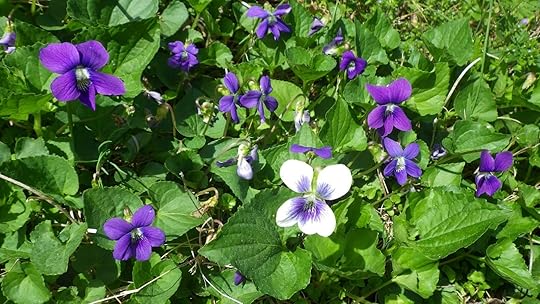
These beautiful little plants are a prime source of Vitamin C. The flowers are beautiful, with a delicate flavor. They also have an anti-depressant effect for many people. They go as well in fruit salads as they do in salads of mixed greens The leaves have a surprisingly mild, gently tart flavor and mix well with lettuce and other mild greens. I like them on sandwiches as well. The leaves have the helpful property of getting your lymph system flowing, which is great in the spring after a long winter of staying indoors. Violets prefer cold weather and will begin to wither as the heat of summer comes on, but they do well in containers, so it’s quite feasible to dig up a couple and keep them in pots in the house over the summer. Do be aware that the African violet plants you find in garden centers are NOT the same as the lovely Viola odorata. They are not edible. So stick with the lovely ‘weeds’ and enjoy a delightful taste of spring!
Chickweed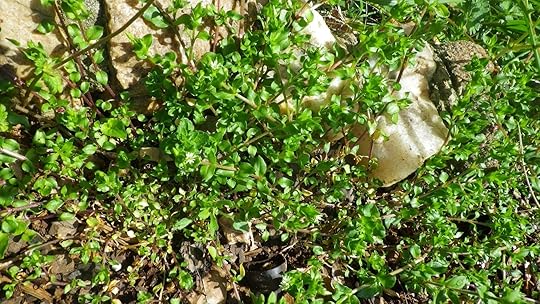
I’ll admit, I’ve been known to pick this stuff by the handful and eat it while I’m working in the garden. It has a thirst-quenching property that feels very refreshing. Like the violet, chickweed (Stellaria media) is a cool weather plant, providing me with delicious greens before much of anything else is sprouting in the garden. I like to base a tossed salad in chickweed (it’s really plentiful here) and pile it high on sandwiches. It also makes a delicious pesto if you substitute it for all or part of the basil in your favorite recipe. The leaves have a texture similar to spinach, so I like to substitute it in any recipe that calls for raw spinach. It’s especially tasty chopped coarsely and tossed with hot pasta.
Plantain
You’ve probably seen this ‘lowly weed’ growing along footpaths and other places where people walk. It’s surprisingly sturdy and also…tasty. The older leaves can be a bit tough, so choose the younger ones. The flavor is mild, not at all bitter, and the flat leaves stack nicely on a sandwich or toss easily in a salad. Plantain is also my favorite bug bite treatment. A plantain poultice quickly relieves the discomfort of mosquito bites and bee or wasp stings. The fast way to make a poultice if you’re out hiking: pick a leaf, chew it up well and spit the wad out on the bug bite. Yes, I can hear you saying “Ew!!” But it works, I promise. If you’re at home, you can toss a few leaves in the small jar of a food processor for the same result with less ‘ew factor.’ A plantain poultice also works a treat to draw out splinters from the skin.
Dandelion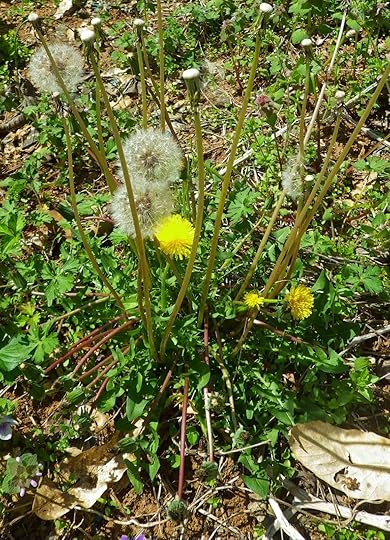
This may be my favorite summertime weed. I love to lie in a patch of dandelions and watch the sun shine through the golden petals as the wind whisks the fuzzy seeds away. Summer isn’t the best time to eat dandelion greens raw in a salad, however. They develop some serious bitterness as they mature. The young leaves that are just beginning to grow in the spring are another story – tender and delicious. The flowers make a tasty addition to a salad as well. If you’re still craving dandelions later in the year and they’re not putting on fresh, new leaves, you can cook the mature leaves as a wild vegetable. I like to put them in water to cover, bring it to a boil, boil it for just a minute then pour off the water. If the greens are very dark and old, I do the same thing again, then simmer them in fresh water until they’re tender. They have the consistency of other hard greens like collards and kale, and are great tossed hot with some Italian salad dressing (weird, I know, but delicious), hot pepper sauce or vinegar.
What weeds will you add to your dinner table this year?
Around my house, we enjoy something called ‘yard salad.’ In cooler weather it contains some traditional lettuce from the vegetable garden, but it also includes many of the plants people work hard to remove from their lawns. They are very high in vitamins and minerals, taste good and look pretty in a salad bowl. I like to joke that if the zombie apocalypse ever comes, the people with the well-kept lawns will be the first to starve!
Here are some of my favorites. They’re in their prime right now, at the height of spring here in the Northern Hemisphere.
Violets

These beautiful little plants are a prime source of Vitamin C. The flowers are beautiful, with a delicate flavor. They also have an anti-depressant effect for many people. They go as well in fruit salads as they do in salads of mixed greens The leaves have a surprisingly mild, gently tart flavor and mix well with lettuce and other mild greens. I like them on sandwiches as well. The leaves have the helpful property of getting your lymph system flowing, which is great in the spring after a long winter of staying indoors. Violets prefer cold weather and will begin to wither as the heat of summer comes on, but they do well in containers, so it’s quite feasible to dig up a couple and keep them in pots in the house over the summer. Do be aware that the African violet plants you find in garden centers are NOT the same as the lovely Viola odorata. They are not edible. So stick with the lovely ‘weeds’ and enjoy a delightful taste of spring!
Chickweed

I’ll admit, I’ve been known to pick this stuff by the handful and eat it while I’m working in the garden. It has a thirst-quenching property that feels very refreshing. Like the violet, chickweed (Stellaria media) is a cool weather plant, providing me with delicious greens before much of anything else is sprouting in the garden. I like to base a tossed salad in chickweed (it’s really plentiful here) and pile it high on sandwiches. It also makes a delicious pesto if you substitute it for all or part of the basil in your favorite recipe. The leaves have a texture similar to spinach, so I like to substitute it in any recipe that calls for raw spinach. It’s especially tasty chopped coarsely and tossed with hot pasta.
Plantain

You’ve probably seen this ‘lowly weed’ growing along footpaths and other places where people walk. It’s surprisingly sturdy and also…tasty. The older leaves can be a bit tough, so choose the younger ones. The flavor is mild, not at all bitter, and the flat leaves stack nicely on a sandwich or toss easily in a salad. Plantain is also my favorite bug bite treatment. A plantain poultice quickly relieves the discomfort of mosquito bites and bee or wasp stings. The fast way to make a poultice if you’re out hiking: pick a leaf, chew it up well and spit the wad out on the bug bite. Yes, I can hear you saying “Ew!!” But it works, I promise. If you’re at home, you can toss a few leaves in the small jar of a food processor for the same result with less ‘ew factor.’ A plantain poultice also works a treat to draw out splinters from the skin.
Dandelion

This may be my favorite summertime weed. I love to lie in a patch of dandelions and watch the sun shine through the golden petals as the wind whisks the fuzzy seeds away. Summer isn’t the best time to eat dandelion greens raw in a salad, however. They develop some serious bitterness as they mature. The young leaves that are just beginning to grow in the spring are another story – tender and delicious. The flowers make a tasty addition to a salad as well. If you’re still craving dandelions later in the year and they’re not putting on fresh, new leaves, you can cook the mature leaves as a wild vegetable. I like to put them in water to cover, bring it to a boil, boil it for just a minute then pour off the water. If the greens are very dark and old, I do the same thing again, then simmer them in fresh water until they’re tender. They have the consistency of other hard greens like collards and kale, and are great tossed hot with some Italian salad dressing (weird, I know, but delicious), hot pepper sauce or vinegar.
What weeds will you add to your dinner table this year?
Published on April 10, 2014 05:32
March 13, 2014
Book Review: Starcat's Corner
Today I'm reviewing a unique book titled Starcat's Corner: Essays on Pagan Living. Find all my book reviews here.

This book is different – in a good way. It’s a collection of essays the author wrote over the course of a decade, each one focused on a practical method for observing the turning of the seasons as a Pagan in a society in which that spirituality is the minority. There is a certain ritualy-ness to some of them (don’t we all like a little ritual in our lives?) but most of them focus more on deepening earth-oriented spirituality through daily life, a sort of Pagan mindfulness, if you will.
I was delighted to read the essay about Pagan homeschooling – yes, there are more of us out there than you might think. And Starcat’s thoughts on incorporating Pagan spirituality into everyday activities from gardening to journaling to working a job help ground our collection of traditions in real life in a very hands-on way. Of course, it’s delightful to gather at the Sabbats and celebrate through ritual, but it’s also important to remain mindful of our values and traditions throughout every ordinary day. We are Pagans every day, not just at the Turning Points. Starcat’s Corner shows us how to bring earth-oriented spirituality to life in a very hands-on, real-world way.
Find more information about this book on the publisher's website. It is available on Amazon.com, Amazon.co.uk, and other online and brick-and-mortar booksellers.

This book is different – in a good way. It’s a collection of essays the author wrote over the course of a decade, each one focused on a practical method for observing the turning of the seasons as a Pagan in a society in which that spirituality is the minority. There is a certain ritualy-ness to some of them (don’t we all like a little ritual in our lives?) but most of them focus more on deepening earth-oriented spirituality through daily life, a sort of Pagan mindfulness, if you will.
I was delighted to read the essay about Pagan homeschooling – yes, there are more of us out there than you might think. And Starcat’s thoughts on incorporating Pagan spirituality into everyday activities from gardening to journaling to working a job help ground our collection of traditions in real life in a very hands-on way. Of course, it’s delightful to gather at the Sabbats and celebrate through ritual, but it’s also important to remain mindful of our values and traditions throughout every ordinary day. We are Pagans every day, not just at the Turning Points. Starcat’s Corner shows us how to bring earth-oriented spirituality to life in a very hands-on, real-world way.
Find more information about this book on the publisher's website. It is available on Amazon.com, Amazon.co.uk, and other online and brick-and-mortar booksellers.
Published on March 13, 2014 04:51
February 26, 2014
Who's Sorry Now?
Male friend: “I lost my job yesterday.”
Me: “I’m sorry.”
Male Friend: “It’s not your fault.”
Me: “That’s not what I meant.”
I’ve had a number of exchanges almost exactly like this one over the past year or two and I’m beginning to think the perceived meaning of the phrase “I’m sorry” has an unwitting gender bias. Yes, from my experience it appears that, in general, men ascribe a different meaning to the phrase than women do. To be more precise, the men I know allow the phrase only one meaning while women ascribe it two distinct definitions. Please bear with me while I explain my ideas to you, then you can let me know whether or not I’m just going crazy.

When we’re small, our parents teach us to say “I’m sorry” when we have harmed someone, accidentally or on purpose. The meaning is clear: I regret what I have done. I apologize. Not that the average three-year-old necessarily regrets whacking their sibling with a toy, but eventually they understand the other person’s point of view and generate sincere apologies.
This meaning of “I’m sorry” follows us throughout our lives. When I bump into someone as I’m rounding the corner in the grocery story, I automatically use that phrase. Every English-speaking adult I know says “I’m sorry” when they mean “I apologize.” There is no confusion here.
The problem is that some people attach a second meaning to those words. It’s the second meaning that I employed in the sample conversation above, and it’s this second meaning that many men apparently don’t recognize. In this case, “I’m sorry” means “I sympathize, I feel your pain.”
Within my hearing, the most common use of this second meaning occurs around the unfortunate circumstance of the death of loved ones. In this sort of situation, I hear women say “I’m sorry” and in that situation whoever they’re talking to will usually understand their meaning as “I sympathize.” I have occasionally (OK, rarely) heard men use the same words in the same situation and the recipient of their comments also understands this second meaning. But outside this narrow circumstance, the sympathy meaning of “I’m sorry” seems to disappear from men’s mental dictionaries and they automatically ascribe the apology meaning to the phrase, resulting in my having to explain myself, as in the sample conversation at the top of this post.
Is it just me? Women, has this ever happened to you? Men, do you assume “I’m sorry” means “I apologize” or have I just managed to experience an unusual slice of the population that uses the phrase this way?
In thinking back over the past few years, I can’t remember a single conversation in which a man has used the phrase “I’m sorry” to mean “I sympathize.” Of course, men do sympathize with others, but in my experience they express their meaning with words such as “That’s awful” or “That totally sucks.”
“I’m sorry” is such a reflex response for me in so many situations, I expect it would be hard to retrain myself to use different phrases. But I’m seriously considering switching to “I apologize” and “I sympathize” simply so I don’t have to explain myself so often. What do you think?
Me: “I’m sorry.”
Male Friend: “It’s not your fault.”
Me: “That’s not what I meant.”
I’ve had a number of exchanges almost exactly like this one over the past year or two and I’m beginning to think the perceived meaning of the phrase “I’m sorry” has an unwitting gender bias. Yes, from my experience it appears that, in general, men ascribe a different meaning to the phrase than women do. To be more precise, the men I know allow the phrase only one meaning while women ascribe it two distinct definitions. Please bear with me while I explain my ideas to you, then you can let me know whether or not I’m just going crazy.

When we’re small, our parents teach us to say “I’m sorry” when we have harmed someone, accidentally or on purpose. The meaning is clear: I regret what I have done. I apologize. Not that the average three-year-old necessarily regrets whacking their sibling with a toy, but eventually they understand the other person’s point of view and generate sincere apologies.
This meaning of “I’m sorry” follows us throughout our lives. When I bump into someone as I’m rounding the corner in the grocery story, I automatically use that phrase. Every English-speaking adult I know says “I’m sorry” when they mean “I apologize.” There is no confusion here.
The problem is that some people attach a second meaning to those words. It’s the second meaning that I employed in the sample conversation above, and it’s this second meaning that many men apparently don’t recognize. In this case, “I’m sorry” means “I sympathize, I feel your pain.”
Within my hearing, the most common use of this second meaning occurs around the unfortunate circumstance of the death of loved ones. In this sort of situation, I hear women say “I’m sorry” and in that situation whoever they’re talking to will usually understand their meaning as “I sympathize.” I have occasionally (OK, rarely) heard men use the same words in the same situation and the recipient of their comments also understands this second meaning. But outside this narrow circumstance, the sympathy meaning of “I’m sorry” seems to disappear from men’s mental dictionaries and they automatically ascribe the apology meaning to the phrase, resulting in my having to explain myself, as in the sample conversation at the top of this post.
Is it just me? Women, has this ever happened to you? Men, do you assume “I’m sorry” means “I apologize” or have I just managed to experience an unusual slice of the population that uses the phrase this way?
In thinking back over the past few years, I can’t remember a single conversation in which a man has used the phrase “I’m sorry” to mean “I sympathize.” Of course, men do sympathize with others, but in my experience they express their meaning with words such as “That’s awful” or “That totally sucks.”
“I’m sorry” is such a reflex response for me in so many situations, I expect it would be hard to retrain myself to use different phrases. But I’m seriously considering switching to “I apologize” and “I sympathize” simply so I don’t have to explain myself so often. What do you think?
Published on February 26, 2014 04:44
February 19, 2014
Book Review: The Druid Shaman
Today I'm reviewing a book in the Shaman Pathways series, titled The Druid Shaman: Exploring the Celtic Otherworld, by Danu Forest. Find all my book reviews here.
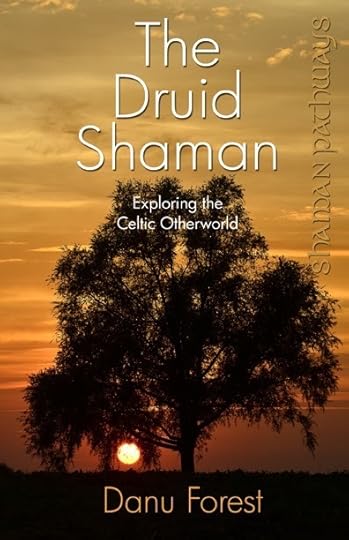
I really didn't know what to expect from this book; Druidry and shamanism are two traditions that are not often linked, and as a shamanic practitioner, I'm far more familiar with the latter. But as I read, I was fascinated and impressed. Danu Forest makes the case for Druidry, in its original form, as the native shamanic tradition of the Celts. The shape-shifting and world-traveling heroes from ancient Celtic tales draw us into the customs and practices of the ancestral Celts with their music, their tools, their rituals.
While Ms. Forest gives plenty of background regarding the Celtic spiritual traditions, particularly those with a shamanic bent, this is largely a practical book. It takes the reader through the process of creating shamanic tools, finding spirit allies in nature, connecting with the ancestors, traveling among the worlds and seeking knowledge of the future through divination. I do recommend following it up with further training if you intend to continue with shamanic practice but this book provides a firm foundation for basic shamanic practice in a Celtic style and is an excellent starting point for those who are interested in this path.
Find more information about this book on the publisher's website. It is available on Amazon.com, Amazon.co.uk, and other online and brick-and-mortar booksellers.

I really didn't know what to expect from this book; Druidry and shamanism are two traditions that are not often linked, and as a shamanic practitioner, I'm far more familiar with the latter. But as I read, I was fascinated and impressed. Danu Forest makes the case for Druidry, in its original form, as the native shamanic tradition of the Celts. The shape-shifting and world-traveling heroes from ancient Celtic tales draw us into the customs and practices of the ancestral Celts with their music, their tools, their rituals.
While Ms. Forest gives plenty of background regarding the Celtic spiritual traditions, particularly those with a shamanic bent, this is largely a practical book. It takes the reader through the process of creating shamanic tools, finding spirit allies in nature, connecting with the ancestors, traveling among the worlds and seeking knowledge of the future through divination. I do recommend following it up with further training if you intend to continue with shamanic practice but this book provides a firm foundation for basic shamanic practice in a Celtic style and is an excellent starting point for those who are interested in this path.
Find more information about this book on the publisher's website. It is available on Amazon.com, Amazon.co.uk, and other online and brick-and-mortar booksellers.
Published on February 19, 2014 04:51



